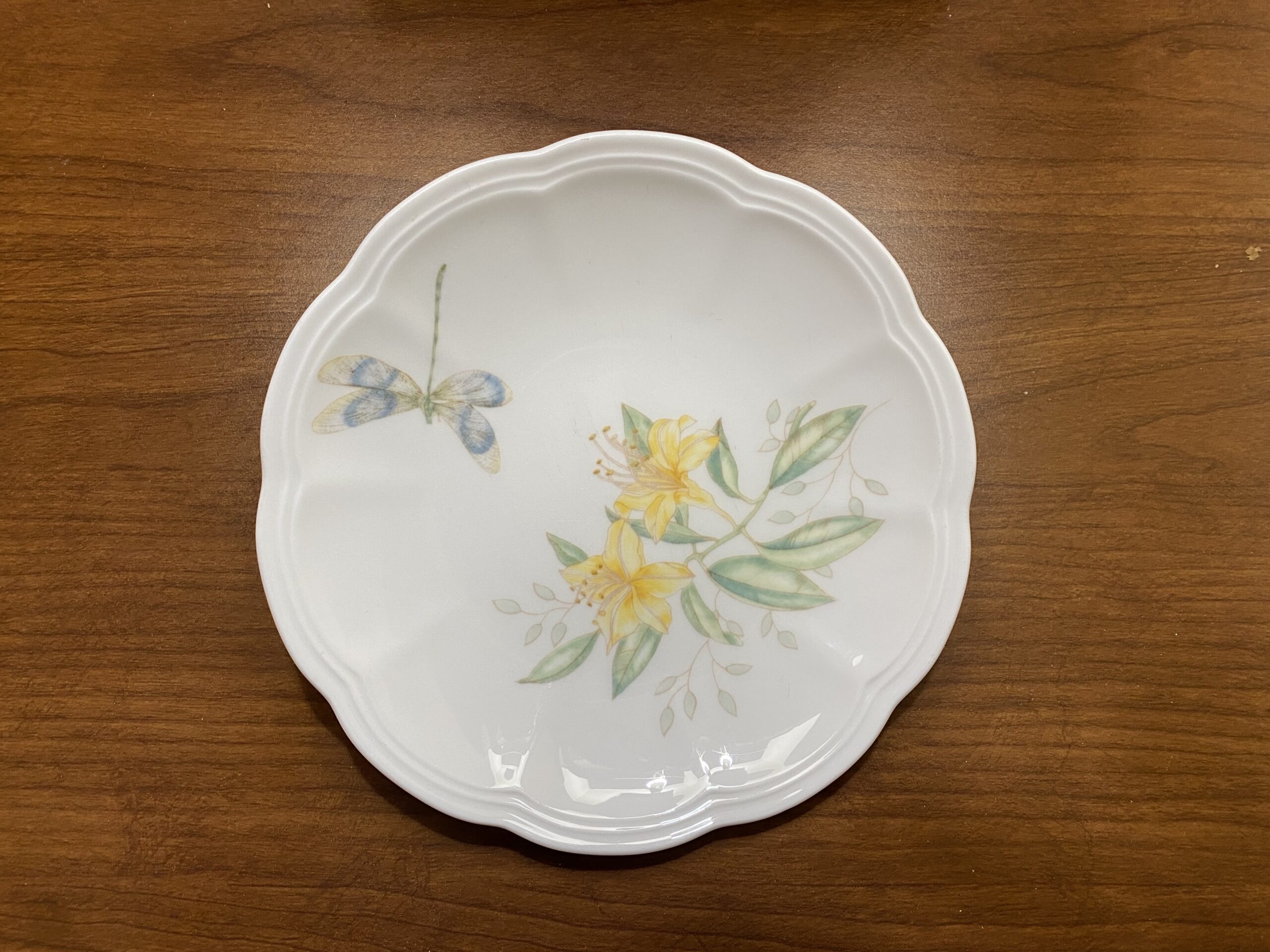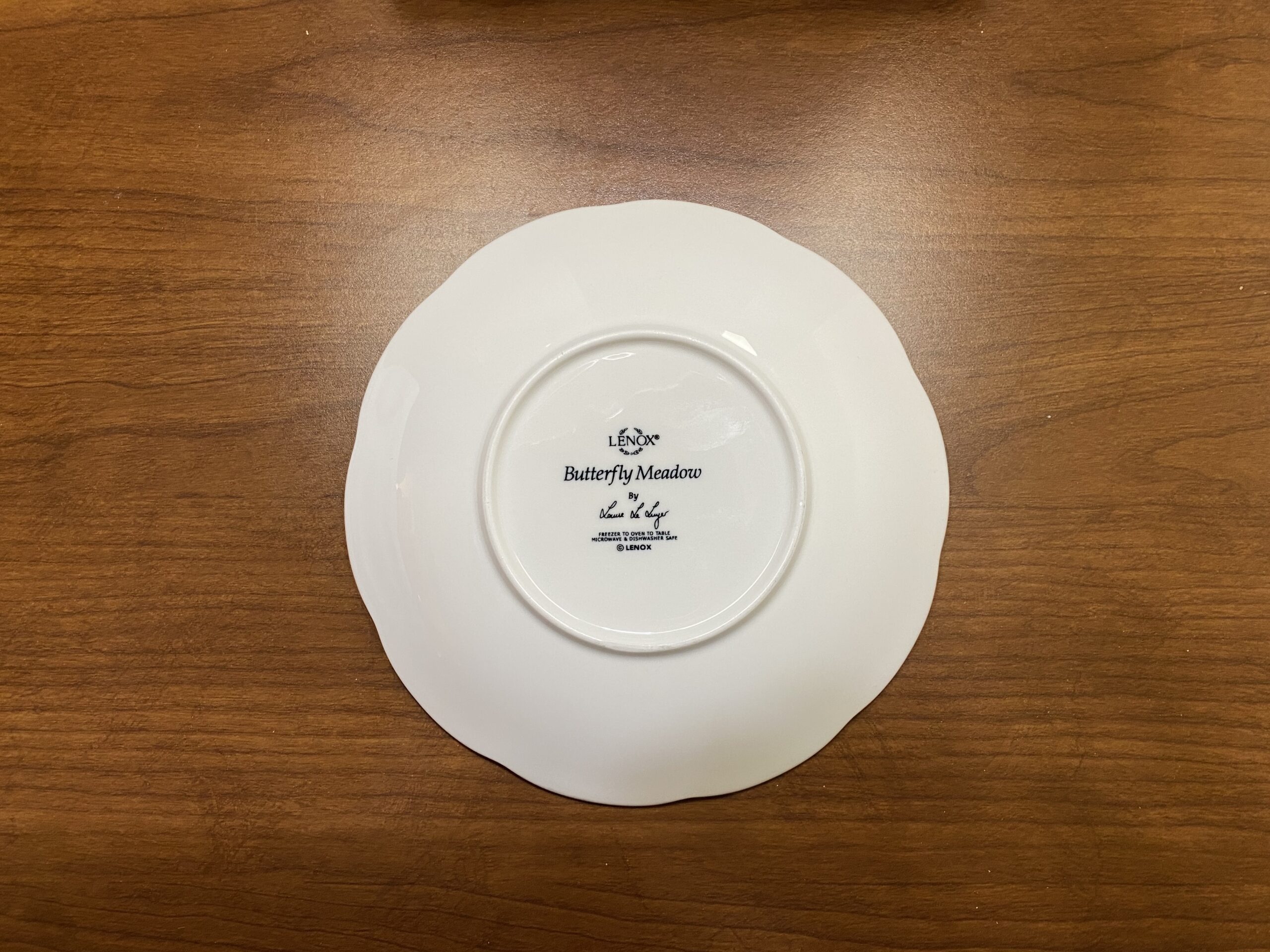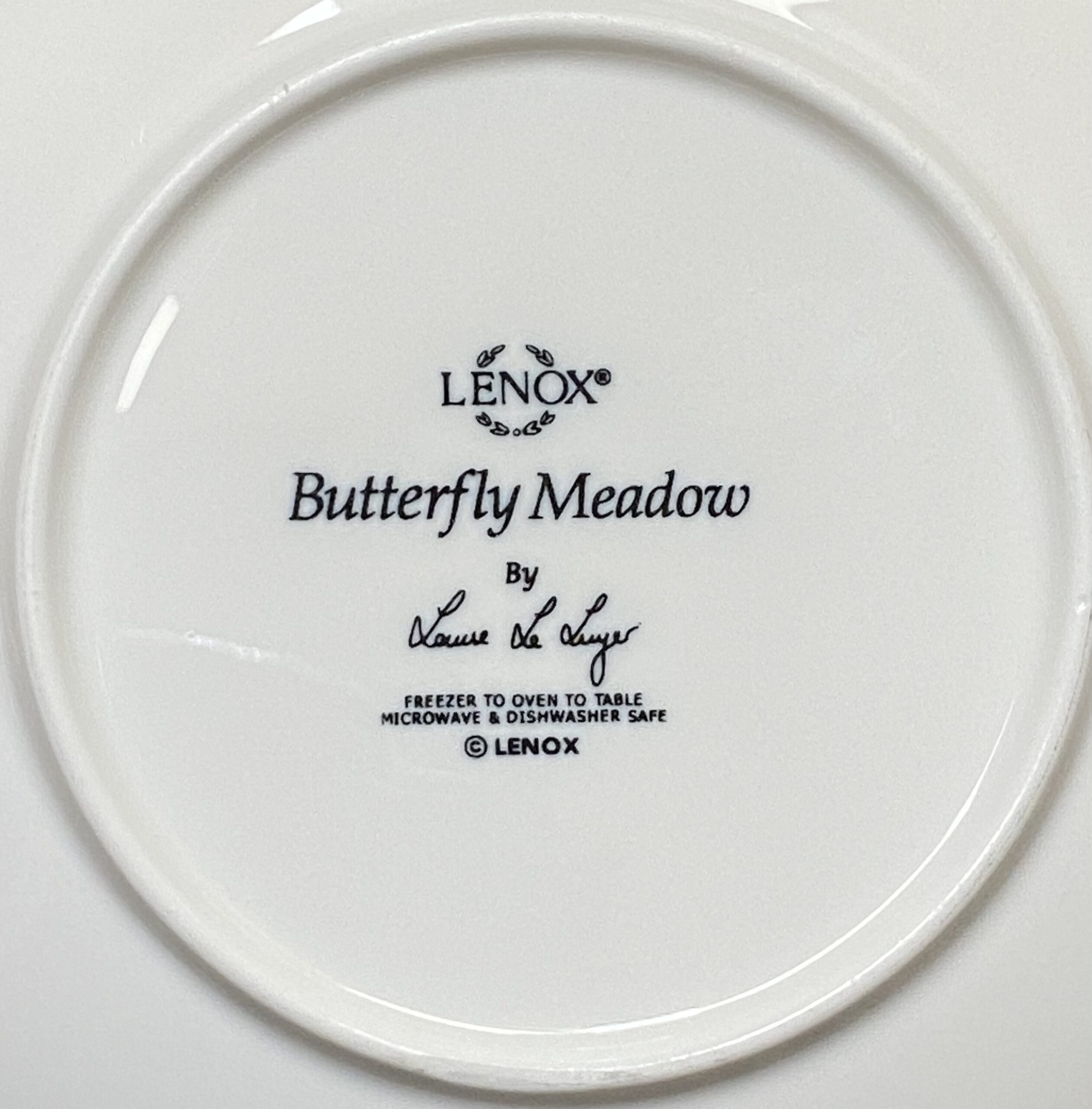China brands associated with “quality” aren’t necessarily safe. 2001 Lenox Butterfly Meadow pattern china: 63,700 ppm Lead
For those new to the Lead Safe Mama website:
Tamara Rubin is a multiple-federal-award-winning independent advocate for childhood Lead poisoning prevention and consumer goods safety, and a documentary filmmaker. She is also a mother of Lead-poisoned children (two of her four sons were acutely Lead-poisoned in 2005).
- Tamara owns and runs Lead Safe Mama, LLC — a unique community collaborative woman-owned small business for childhood Lead poisoning prevention and consumer goods safety.
- Since July 2022, the work of Lead Safe Mama, LLC has been responsible for six product recalls (FDA and CPSC).
- All test results reported on this website are science-based, accurate, and replicable.
- Please check out our press page to see news coverage of our work.

 When tested with an XRF instrument, the 2001 Butterfly Meadow pattern china dish pictured above featured the following readings:
When tested with an XRF instrument, the 2001 Butterfly Meadow pattern china dish pictured above featured the following readings:
Glaze on the food surface of the dish
(the white and colored areas all resulted in similar readings):
- Lead (Pb): 63,700 +/- 2,000 ppm
- Cadmium (Cd): 97 +/- 14 ppm
- Barium (Ba): 138 +/- 63 ppm
- Zirconium (Zr): 4,271 +/- 167 ppm
- Zinc (Zn): 1,126 +/- 74 ppm
- Iron (Fe): 829 +/- 167 ppm
- Titanium (Ti): 362 +/- 181 ppm
This is NOT illegal.
Newly manufactured items intended for use by children today (post-2011) are considered illegal (and unsafe) if the paint, glaze or coating is 90 ppm Lead (or higher). China (and any dishware for that matter) is not considered to be an “item intended for use by children” and therefore is not regulated for total Lead content in the paint, glaze or decorative elements. As a result, even brand new china can have unsafe levels of Lead (unsafe when compared to the regulatory standards for items intended for use by children).
Are these readings accurate?
Test results reported here on the Lead Safe Mama website are accurate, replicable, and science-based. A full set of XRF test results is always reported, however tests are conducted multiple times to confirm the results. Each set of results reported is from a 60-second test unless otherwise noted. All components and colors are tested. The instrumentation used for the testing published on this site is the same XRF method the United States Consumer Product Safety Commission uses when testing consumer goods for the presence toxic heavy metals (like Lead, Cadmium, Arsenic, and Mercury). To learn more about the testing we report here at Lead Safe Mama, click here.
What does Lenox have to say about this?
When Lenox has been approached about the concern for Lead in their dishware (over the past 12 years since I have been testing their products) their representatives have repeated the same party line that has been shared so many other companies who have made dishware (or other products) for more than a decade. The majority of these companies that have been in business for decades often say something (in response to inquiries from my readers) that makes it sound like their products are always safe and have always been safe. For example the language usually is along the lines of “Our products have always met or exceeded all regulatory standards at the time of manufacture.” These types of comments are doublespeak given the extreme changes in safety standards over the years, and are a way for the company to specifically avoid taking responsibility for historically toxic products that may not be considered safe if manufactured today.
Here are some examples of other companies who have responded to my testing in this way (deflecting blame or hiding the truth in doublespeak as a way of denying any historic or current wrongdoing.)
- Here’s how Corningware has responded to the same concern.
- Here’s how Tupperware has responded to the findings of Lead, Mercury and Arsenic in their vintage products.
- Here’s how Corelle has responded to the concern for Lead in their dishes.
- Here’s how Xtrema / Ceramcor responded to my findings of Lead (and many other metals) in their “metals-free” pans.
- Here’s Young Living’s response to my findings of Lead in their diffusers.
- Here’s DoTerra’s response (also to my findings of Lead in their diffusers)
- Here’s Green Sprouts’ response to my findings of Lead paint on their infant sippy cups.
- Here’s Pura Kiki’s response to findings of Lead in their insulated stainless steel baby bottles.
A handful of companies have responded much more proactively to my findings of unsafe levels of Lead in products they either manufacture or sell:
- Here’s Fisher Price’s response to the findings of Lead in their vintage toys.
- Here’s Instant Pot’s response to my findings of Lead in their products.
- Here’s Jervis & George’s response to my findings of Lead in their infant feeding products.
- Here’s Mighty Nest’s response to my reporting of Lead in one of the products they were selling.
At the time of writing this, I don’t have a specific response example from Lenox available, but I am going to dig through my archives and check with my readers and I will update this post with an example as soon as I can find it.
The main concern is not whether or not dishes met the regulatory standards at the time of manufacture, but how are they holding up (from a toxics perspective) two decades later.
While these Lenox Butterfly Meadow dishes may have complied with regulatory limits for leaching of Lead (from their highly Leaded glazes) at the time of manufacture, the likelihood that they are not now leaching Lead, 20 years later… after two decades of regular daily use as intended (including use in the dishwasher, microwave and freezer! …as all are labeled appropriate)… is slim. In my experience, dishes with Lead levels this high are highly likely to be leaching at unsafe levels given the age and normal usage patterns, when used as intended. You can read more about those specific concerns here, link.
Some additional reading for those who want to dig a little deeper into this subject:
- First, here is a video that shows you how to quickly and efficiently use the site (there are over 2,600 articles and pages with information here at the time of publishing this piece, with new reports added daily).
- Here is our “Lenox” overview, with links to all of the other Lenox examples I have tested. If you scroll through the examples you will note that most are positive for at least some Lead (until about 2015.)
- I have several articles about choosing Lead-free dishes for your family. You will see how to find them all when you watch the video, but you can also click on these three for starters: See ONE, TWO, and THREE.
As always thank you for reading and sharing this work. Please let me know if you have any questions. I will do my best to answer them personally although it may take a long time (there were over 1,100,000 unique individual readers here on Lead Safe Mama dot com in 2020, from over 200 countries, so I cannot realistically answer each and every question thought I may try! To see all the countries Lead Safe Mama readers are tuning in from as of 2020, click here.
Tamara Rubin
#LeadSafeMama
Never Miss an Important Article Again!
Join our Email List







Tamara, I have been following your blog for a few years now. I am so thankful for all your research and for this blog! I’ve learned so much from you!
I used a bowl from this Lenox butterfly meadow line earlier today at someone’s home to feed my baby. I’m not sure of the age of the bowl but I am assuming there is only one ‘butterfly meadow’ line. I had a suspicion that it may be high in lead but still continued to use it because I didn’t want to be rude. But now I am panicking! Would a one-time use leach enough lead to be toxic to a baby? It had hot food in it.
Thank you!
Hi Patricia. Depending on the age and usage of the bowl … even if it were leaching (which is very possible)… I expect a one time usage is not enough to create a measurable blood lead level impact. I would follow up with some extra garlic in the diet over the next couple of days as a precautionary measure. This exact same thing happened with my kiddo and he just refused to eat (thank god!) It never helps to worry about the past of course… and food-based interventions are always good to add to the diet. Here’s m post about that: https://tamararubin.com/2019/07/click-the-link-to-learn-more-wait-what-is-this-click-bait-what-are-you-selling/
Tamara
Tamara l have the butterfly meadow but it is white with no colored decorations.
How old is it?
It is called cloud and about 15 yrs old.
I’m sorry it is Lenox but called cloud. All white and l have a set
Tamara, Do l have to throw away my Lenox white dishes called CLOUD. They look similar to Butterfly Meadows but with no colored paint. They are about 10-15 yrs. old. l asked about this earlier. Thank you
Hi Tamara. There are two runs of the Butterfly Meadow, one that is current and one that is 15-20 years old. From your comments, it seems that you tested the older version of this line (your comments under “Main Concern” above in pink font).
I am wondering if you have tested the new run of this line, the current china? I just bought multiple sets and other items, before I read your blog. But, if these are not an issue, it would be nice to know.
Especially, if they did actually address the lead levels in the new version. (and if they are lower in lead, perhaps the blog could be updated to be fair to Lenox).
Thank you, Elise
If they were manufactured in the past 5 years Lenox items may be lead-free.
Tamara
“May” – meaning you have not tested the current run and so we just do not know? I am now afraid to use my china. Yikes. Can I use a testing kit to be sure? This series is pretty popular, any chance you would want to test the new stuff? Thanks for all you do. 🙂
Hi Elise – May… = “likely” if manufactured in last 5 years. Much of the brand new Lenox has been Lead-free. As you approach 10 years old and older they are more likely to have Lead. Haven’t tested the new ones.
Home test kits don’t work on most dishes:
https://tamararubin.com/2017/02/ask-tamara-q-can-i-test-my-dishes-for-lead-with-a-leadcheck-swab-a-sometimes-but-not-always-click-to-read-more/
Here’s how to send something in for testing:
https://tamararubin.com/2019/08/tamara-can-i-send-you-one-of-my-dishes-to-test-for-lead/
T
Hi, I have the Corelle Zenith pattern. Could you please advise on its lead/ cadmium toxicity? Thanks so much!